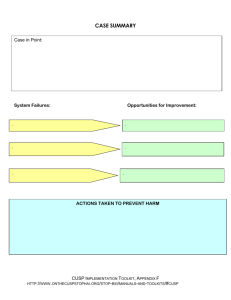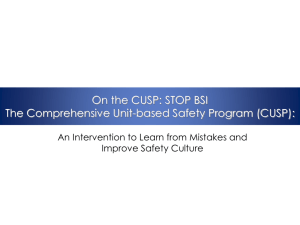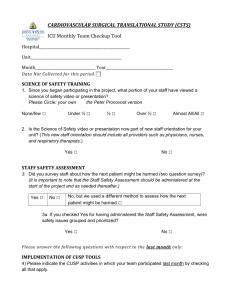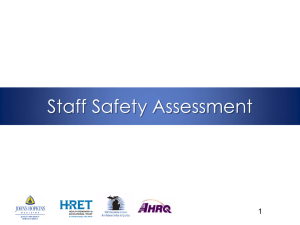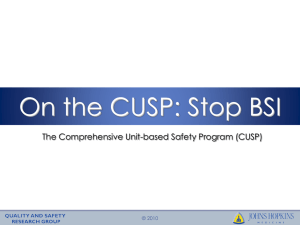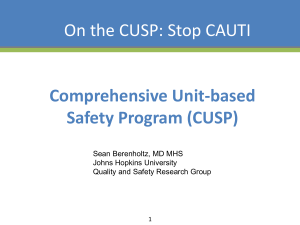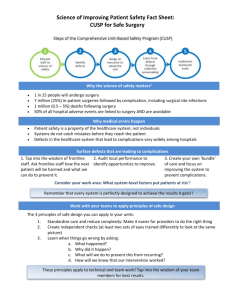This work is licensed under a . Your use of this
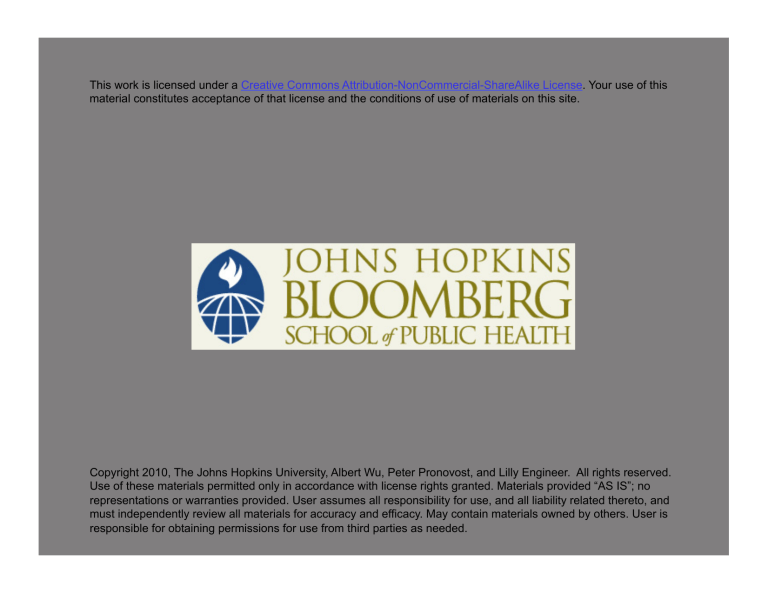
This work is licensed under a Creative Commons Attribution-NonCommercial-ShareAlike License . Your use of this material constitutes acceptance of that license and the conditions of use of materials on this site.
Copyright 2010, The Johns Hopkins University, Albert Wu, Peter Pronovost, and Lilly Engineer. All rights reserved.
Use of these materials permitted only in accordance with license rights granted. Materials provided “AS IS”; no representations or warranties provided. User assumes all responsibility for use, and all liability related thereto, and must independently review all materials for accuracy and efficacy. May contain materials owned by others. User is responsible for obtaining permissions for use from third parties as needed.
CUSP: Designing a Comprehensive Unit-based
Patient Safety Program
Albert Wu, MD, MPH
Peter Pronovost, MD, PhD
Lilly Engineer, MD, DrPH, MHA
Johns Hopkins University
CUSP: The Concept
CUSP is a five-step program designed to impact safety climate by empowering staff to assume responsibility for safety in their environment
CUSP is a strategic intervention that provides a road map to learn from mistakes, improve safety culture, and improve systems to make them safer
CUSP helps achieve the above through …
Education and awareness
Enabling access to organizational resources
Providing and helping develop a toolkit of interventions
3
CUSP: The Concept (cont.)
Goals
Improve patient safety
Improve safety culture
Integrate safety practices in daily work
Five-step framework implemented at the unit level
Cyclical process not linear
4
CUSP: Getting Started
Pre-CUSP work
CUSP steps
5
Pre-CUSP Work
Obtain leadership support
Assemble a safety team, including …
Project leader/unit champion (e.g., RN or MD leader)
Nurse manager
Physician champion
Other integral members of unit (e.g., pharmacist, respiratory therapist)
Senior executive (e.g., CEO, dean, president)
Assess unit safety culture using a validated instrument and rigorous survey methodology
6
Pre-CUSP Work: Why Culture Matters
Decubitus ulcers in med/surg units
Delays in OR and ICU
Bloodstream infections in the
ICU
VAP in the ICU
Wrong-site surgeries
Post-op sepsis
Post-op infections
PE/DVT per 1,000 surgical discharges
RN turnover
Absenteeism
Incident reporting rates/ reporting harm
Burnout
Spirituality
Unit size
Source: J. Bryan Sexton. 7
CUSP: The Five Steps
1.
Educate staff on science of safety
2.
Identify defects
3.
Senior executive to partner with unit
4.
Learn from one defect per month/quarter
5.
Implement teamwork tools
Source: Pronovost. (2005). 8
Step 1: Science of Safety Education
Purpose
To bring everyone on the unit on the same page with regard to the concept and knowledge of patient safety (systems theory, concepts of safe design, investigation of system defects)
To highlight how they can make a difference
Process
Safety trainers deliver the talk in person
Large group training is more efficient
Track staff trained with attendance sheet (form)
Distribute staff safety survey form at end of training
Challenges: Educating everyone (each shift)
Solutions: Educate in smaller groups, use online training version— http://www.jhsph.edu/ctlt/training/patient_safety.html
9
Step 2: Staff Identify Defects
Purpose
Tap into expertise and knowledge of frontline providers
Empower and engage in safety
Process
Staff safety assessment survey (form—two questions)
Assign one person the task of survey administration
Collate and group responses into common defects (e.g., communication, patient falls)
Consider existing data sources like event reports, sentinel events, patient satisfaction, M&Ms, claims
Periodically repeat this step
Challenges: Hesitant to speak up/write, logistics of preparing a collated, actionable report
Solutions: Make it anonymous, CUSP rounds
10
Step 2: Staff Identify Defects (cont.)
Components of staff safety survey
11
Step 3: Senior Executive Partnership
Purpose
Connect senior management with frontline providers
Speedily address safety issues and remove barriers for implementing improvements
Advocate for unit (at the institution level)
Process
Preplan: Project leader finds out the number of units implementing CUSP and the number of senior executives available—enough for each unit?
Unit safety team meet and orient executive
Set up monthly safety rounds with executive
Brief frontline providers about purpose of safety rounds
Safety rounds: Discuss safety issues (from Step 2—executive, safety team, and unit staff); document safety issues discussed
Identify and manage improvement projects
12
Step 3: Senior Executive Partnership (cont.)
Challenges
Executive’s busy schedules
Fewer executives than units
Not as many executives aware of patient safety
Solutions
Adapt CUSP meetings to executive and staff availability
Let leaders spread the word
Expand the pool of executives
One executive adopts more than one unit
13
Step 4: Learning from Defects
Purpose
Investigate why system(s) failed and implement improvement efforts
For eliminating sources of potential harm at a steady but sure pace (“de-weeding”)
Process
Identify safety defect
Investigate at least one defect per ____
Complete case summary form
Share case summary (optional)
14
Step 4: Learning from Defects (cont.)
Components of learning from defects
What happened?
Why did it happen (system lenses)?
What could you do to reduce risk?
How do you know risk was reduced?
Create policy/process/procedure
Ensure staff know policy
Evaluate if policy is used correctly
Source: Pronovost. (2005). JCJQI. 15
Step 4: Learning from Defects (cont.)
Challenges
Selecting the “right” defects
Institutional bureaucracy
Complexity of problems involving more than one discipline leading to slower solutions
Solutions
Ask the staff which are the three greatest risks
Multi-disciplinary CUSP team
Engage the executive so he/she advocates for the unit
16
Step 5: Teamwork Tools to Improve
Purpose
Practical tools to implement improvements
Enable culture conducive to safety improvement
Examples of tools
Morning briefing (communication and rounding efficiency)
Shadowing profession (collaboration, teamwork, communication)
Daily goals (communication, care plan)
Observe/structure rounds
Source: Pronovost. (2009). JCJQI. 17
CUSP: Moving Forward
A continuous journey
Repeat Steps 4 and 5 identifying new defects and resolving new ones as you go along
Repeat Step 1 when a new staff joins
Share results and successes
18
CUSP Success: Example
Impact on length of stay and nurse turnover in two ICUs
ICU LOS
(days)
% nurse turnover
WICU SICU
Pre-CUSP Post-CUSP Pre-CUSP Post-CUSP
2.2 1.1 3.2 2.3
9 2 8 2
Source: Pronovost.
19
CUSP Success: Example
20
CUSP Success: Example
21
References
Pronovost, P., Weast, B., Rosenstein, B., et al. (2005). Implementing and validating a comprehensive unit-based safety program. J Pat Safety, 1,
1, 33–40.
Pronovost, P., Berenholtz, S., Dorman, T., Lipsett, P. A., Simmonds, T., and Haraden, C. (2003). Improving communication in the ICU using daily goals. J Crit Care, 18, 2, 71–75.
Pronovost, P. J., Weast, B., Bishop, K., et al. (2004). Senior executive adopt-a-work unit: A model for safety improvement. Jt Comm J Qual
Saf, 30, 2, 59–68.
Thompson, D. A., Holzmueller, C. G., Cafeo, C. L., Sexton, J. B., and
Pronovost, P. J. (2005). A morning briefing: Setting the stage for a clinically and operationally good day. Jt Comm J Qual and Saf, 31, 8,
476–479.
Holzmueller, C. G., Timmel, J., Kent, P. S., Schulick, R. D., and Pronovost,
P. J. (2009). Implementing a team-based daily goals sheet in a non-ICU setting. Jt Comm J Qual and Saf, 35, 7, 384–388.
22
Resources
Staff education on patient safety: http://www.jhsph.edu/ctlt/training/patient_safety.html
CUSP successes in ICUs: http://safercare.net/
23
